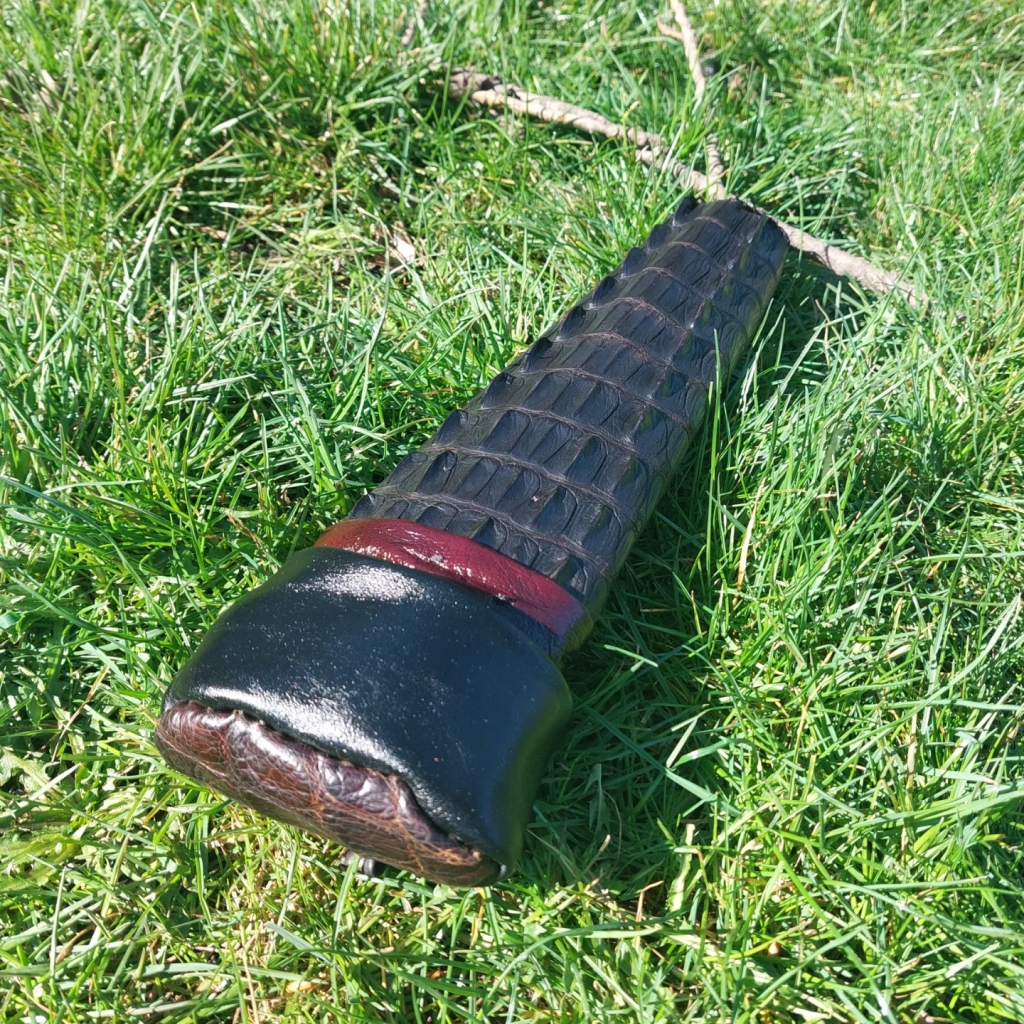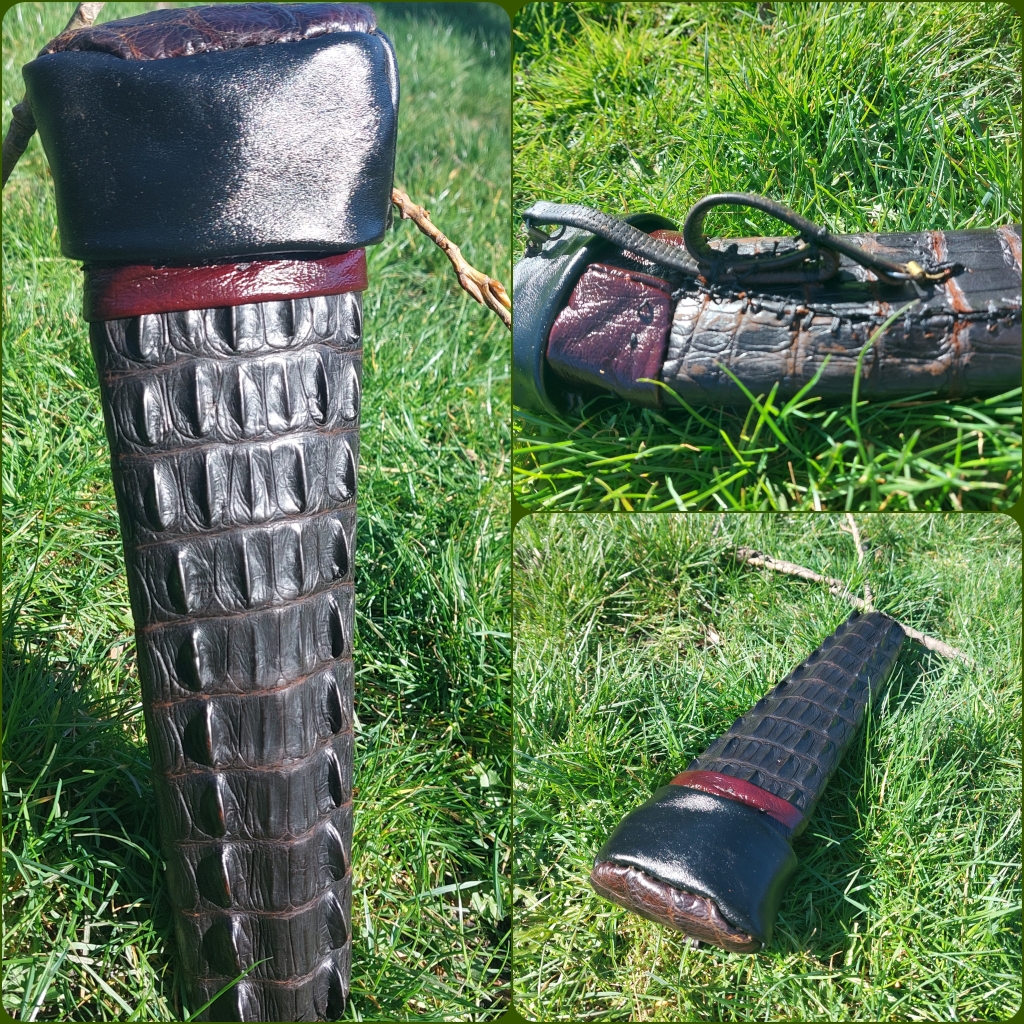In this week’s blog we’ll take a look at some of the pros and cons of real skin and faux skin; their ecological impacts and how they are to work with.
Before we sink our teeth in to the topic properly, let’s take a quick look at what I mean by real and faux and why I’m writing this blog.
My crafting hobby and animistic living has brought me plenty of opportunities to use both fresh skins, vintage skins, modern faux and vintage faux. I prefer the former two, but, as I believe in reusing materials where possible it’s always good to look at all options available and so base your future choice on the throwaways of the past.

Real skin is just that, the skin of a living or once living animal. This could be fresh off the body of a roadkill fox, or the hide of a hunted animal, or even centuries old rawhide. More often than not the materials I’m referring to here are ‘leathers’. That is to say they are skin that has undergone a cleansing, preservation and working stage. Usually these are tanned using either alum or tannin solution. Historically, in commercial, and in some cheap leather today, there has been some use of arsenic and other heavy metals.
Faux on the other hand is pretty much plastic. Often vinyls or polyesters, these materials are designed to look like their animal counterparts without necessarily imitating them in other ways. Sometimes these are synthetic compounds layered on to linen or cotton for strength and pliability and so contain some organic fibre.
In the last decade or so there have been some apparently brilliant innovations in terms of making ‘leathers’ from things like mushrooms (similar to the bracket fungi cloth once favoured by some parts of Japan), cactus, pineapples, apples and algae cultures. I have no real experience of these, but, as I understand it they are replicating the fibrous layers of animal skin and so will likely align more closely with the real skin parts of this blog.
As I’ve already said above, I’m a fan of reused things and as such when a source of hide, faux or real, is vintage or at least second hand then it’s fair game for reuse and it’s latent energy and water costs are diminished by virtue of reuse. In short the means of production become a little less concerning if you’re saving something from the bin or landfill.
Having said that we will look in brief at the processes that make both faux and real. Obviously, fresh off the animal doesn’t count as reuse but the localised, home processing need not be anywhere near as toxic or resource intensive as commercial stuff often is. I’m not an advocate of fur or skin taken from animals that are killed purely for their hide and that leaves the rest as waste. We are in a world so full of fabrics and preloved skins that it would seem an unnecessary cruelty to simply extinguish life just for skin and or profit.

The basic processes required for turning skin into leather are skinning, scraping (defleshing), preserving, washing, drying and stretching/softening and finishing. There’s obviously water use in there, often a detergent when commercially processed, and a mix of chemicals used in both the preservation and finishing stages.
Preservation often uses a vegetable based tannin mixture, or an alum salt solution. Neither of these are great for water life if introduced to water ways in any potency, however, tannins are a naturally occurring compound and so will be broken down in time.
Finishing can include the application of dyes, waxes, oils and conditioners to create the desired end look. Home processed skins often also skip the tannins and fats, like egg yolk or brains, followed by smoking to preserve the skins.
Faux skin or fur starts it’s processing as crude oil extraction from which is refined and processed in various polymers from which plastic is made. This plastic is then heated and shaped, coloured and manipulated with various chemical additives and processes until it becomes either a form that can be woven, or a gloop that can be pressed on to a fabric layer from where it can be stamped, coloured, printed on and so forth.
Plastic was originally designed to last, be moldable and be durable while also being cheap to produce, but sadly this is also the main downfall of it as a material. It became the easy option and then with oil being subsidised globally it became the disposable option. Sadly disposable fast fashion has seen this lead to lower quality plastics that don’t age well and lead to ecological nightmares like microplastics.
Sustainability is a double edged sword when used to judge the vintage item and the processed item…. especially when it’s paired with what should happen with resources and what happens in actuality. People don’t always do what they should after all.
What do I mean by that? Well, you’ve likely heard of the ‘buy once’ movement… plastic done right should fit that ethic, but plastic isn’t done with that intention – it’s designed to be disposable and destined to end up in landfill. Especially as clothes and bags etc are designed to be thrown away rather than be repaired once they’re worn a few times or no longer in vogue.
Leather, of all persuasions, is often destined for the same landfill fate, however, it *could* and indeed should be returned to the earth and composted. In time it would break down fully in to soil. Sadly the plastic can take hundreds or thousands of years to fully break down; it is far more likely to degrade in to toxic components or carcinogenic micro plastic that infiltrate living creatures, ourselves included.
In theory, such seemingly long lasting faux material should seem ideal for upcycling and reuse. In truth many start to degrade or become brittle after a decade or so as Ultra Violet radiation begins to cut polymer chains. The plastic will loiter for awfully long times after it has lost it’s desirable properties.

This faux crocodile skin has started to become weaker and brittle after around 40+years. There is nothing I can do to reinvigorate or refresh it’s condition and the off cuts from my crafting have gone to landfill. Landfill contributes to climate change, resource waste and produces harmful leachate as well as swallowing up huge chunks of land and habitat.
Whereas this 1940s crocodile skin has been refreshed, restored somewhat, and is much stronger than it was when it came in to my possession. It had begun to dry and degrade but because of the interlocking fibrous layers of skin being.washed, worked and oiled, it is once again strong.

That’s a short overview of the production processes, impacts and limitations of faux and real skin. There’s also another aspect I see as an animist; honour and respect.
It’s hard to honour something that is fully synthetic – nothing of the lives that passed, millions of years ago, to create fossil fuels, and ergo plastic, remains in a recognisable form.
This is very much the opposite to real skin. You may honour and respect an animal whom you eat or skin from roadkill. You become part of it’s journey onwards and your knife marks join in the discernable fibres and colouring of each hide.
Even with upcycled leather and skins there are features that show it has come from something alive. That animal might have met a brutal end in the name of fashion, or it’s skin might be used alongside it’s meat but you can tell that it lived.
Each skin is as unique as the animal it came from. Each type of skin can be identified down to the species by the features it shows.
Each skin reworked, upcycled and crafted is a skin given a bit more life, more recognition, more honour and, effectively, another payout for the sacrifice of a life.
It is possible in an animist’s world to ask permission to use and even forgiveness for those of our species that saw the demise of the original wearer of said skin. Or more commonly for me, to connect and ask for guidance and wisdom from an animal ally.

So in summary I would always seek to choose real skin for crafting as it can honour an animal’s life, is overall a part of the active carbon cycle, can be reinvigorated and restored, and, can usually be composted once it fails (or it’s offcuts). It’s also very pleasing to work – there’s something ancestral about it.
However, if a faux material comes my way and it isn’t too brittle or degraded then it still deserves reuse to save it from landfill, and us from plastic pollution.
To keep up to date with my crafting and foraging etc follow me on Instagram.








